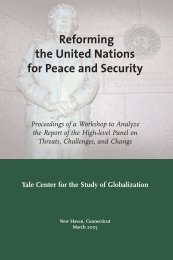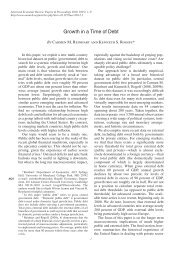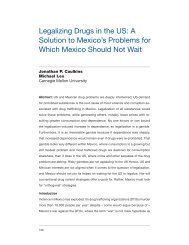The collapse of global trade, murky protectionism, and the crisis:
The collapse of global trade, murky protectionism, and the crisis:
The collapse of global trade, murky protectionism, and the crisis:
Create successful ePaper yourself
Turn your PDF publications into a flip-book with our unique Google optimized e-Paper software.
3. Keeping borders open: why is it important<br />
for Latin America <strong>and</strong> <strong>the</strong> Caribbean <strong>and</strong><br />
what can <strong>the</strong> region do about it?<br />
Luis Alberto Moreno<br />
President <strong>of</strong> <strong>the</strong> Inter-American Development Bank<br />
<strong>The</strong> last time <strong>the</strong> world was engulfed by a <strong>crisis</strong> as severe as we are living now, Latin<br />
America <strong>and</strong> <strong>the</strong> Caribbean (LAC hereafter) virtually closed its door to <strong>the</strong> world<br />
economy. It was not alone in doing that – <strong>the</strong> knee jerk reaction <strong>of</strong> most countries<br />
after <strong>the</strong> 1929 crash was to resort to outright <strong>protectionism</strong>. Yet, whereas most <strong>the</strong><br />
world was on its way to re-embrace <strong>trade</strong> right after World War II, it would take LAC<br />
more than half a century to significantly open its borders <strong>and</strong> shed all <strong>the</strong> misconceptions<br />
about <strong>trade</strong>. This long delay has proved to be ra<strong>the</strong>r costly in lost growth<br />
opportunities <strong>and</strong> <strong>the</strong> region's decision on how to react to <strong>the</strong> current downturn<br />
should be evaluated against this background.<br />
Having history as guide<br />
Whereas turning its back on <strong>trade</strong> did not prevent some <strong>of</strong> <strong>the</strong> largest countries in <strong>the</strong><br />
region from posting high rates <strong>of</strong> growth, it soon became clear that this strategy was<br />
not sustainable <strong>and</strong> a long decade <strong>of</strong> stagnation ensued. LAC fell badly behind o<strong>the</strong>r<br />
developing regions, particularly East Asia nations, which were quick to see <strong>the</strong> growth<br />
benefits <strong>of</strong> <strong>trade</strong>.<br />
<strong>The</strong> region's rapprochement with <strong>the</strong> world economy has not been easy. <strong>The</strong> concerted<br />
effort to bring <strong>trade</strong> back to LAC's growth agenda has <strong>of</strong>ten given ground to<br />
<strong>the</strong> misconception that bringing tariffs down is enough. Free <strong>trade</strong> is no substitute for<br />
strong institutions, sound fiscal <strong>and</strong> monetary policies, robust investment in education<br />
<strong>and</strong>, above all, pure <strong>and</strong> simple hard work. Likewise, <strong>the</strong>re are a number <strong>of</strong> o<strong>the</strong>r<br />
complementary actions governments should purse to boost <strong>the</strong> benefits <strong>of</strong> <strong>trade</strong>,<br />
ranging from investment in infrastructure, to <strong>trade</strong> facilitation <strong>and</strong> to <strong>trade</strong> adjustment<br />
programs.<br />
Learning <strong>the</strong> lessons<br />
We are learning <strong>the</strong>se lessons <strong>the</strong> hard way, as we move, but <strong>the</strong>re is little doubt that<br />
<strong>the</strong> region has made good progress on all <strong>the</strong>se fronts <strong>and</strong> has good results to show.<br />
LAC today can claim that it has <strong>the</strong> most open economy in <strong>the</strong> developing world. All<br />
countries have embraced an ambitious agenda <strong>of</strong> free <strong>trade</strong> agreements <strong>and</strong> have also<br />
liberalized unilaterally <strong>and</strong> multilaterally under <strong>the</strong> WTO. <strong>The</strong> growth benefits,<br />
which were somehow slow to come, have become unmistakable in <strong>the</strong> last decade.<br />
Since 2003, <strong>the</strong> region's GDP has been growing at annual average <strong>of</strong> 5%, driven by a<br />
17% annual growth <strong>of</strong> its exports.<br />
As good as it has been in <strong>the</strong> last years, <strong>the</strong>re is little doubt LAC's growth will suf-<br />
21





